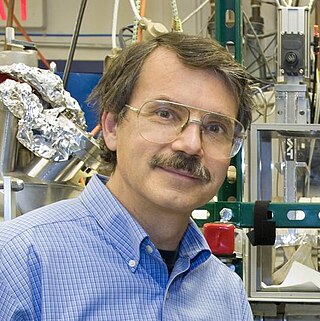Jorge Pullin is an Argentine-American theoretical physicist known for his work on black hole collisions and quantum gravity. He is the Horace Hearne Chair in theoretical Physics at the Louisiana State University.

Alex K. Zettl is an American experimental physicist, educator, and inventor.

Nicholas Harrison FRSC FinstP is an English theoretical physicist known for his work on developing theory and computational methods for discovering and optimising advanced materials. He is the Professor of Computational Materials Science in the Department of Chemistry at Imperial College London where he is co-director of the Institute of Molecular Science and Engineering.

Piers Coleman is a British-born theoretical physicist, working in the field of theoretical condensed matter physics. Coleman is professor of physics at Rutgers University in New Jersey and at Royal Holloway, University of London.
Lucien Hardy is a British-Canadian theoretical physicist currently based at the Perimeter Institute for Theoretical Physics in Waterloo, Canada.
Double ionization is a process of formation of doubly charged ions when laser radiation is exerted on neutral atoms or molecules. Double ionization is usually less probable than single-electron ionization. Two types of double ionization are distinguished: sequential and non-sequential.
Ruth Ann Watson Gregory is a British mathematician and physicist, currently Head of Department of Physics and Professor of Theoretical Physics at King's College London. Her fields of specialisation are general relativity and cosmology.
Robert Tycko is an American biophysicist whose research primarily involves solid state NMR, including the development of new methods and applications to various areas of physics, chemistry, and biology. He is a member of the Laboratory of Chemical Physics in the National Institute of Diabetes and Digestive and Kidney Diseases at the National Institutes of Health in Bethesda, Maryland, USA. He was formerly a member of the Physical Chemistry Research and Materials Chemistry Research departments of AT&T Bell Labs in Murray Hill, New Jersey. His work has contributed to our understanding of geometric phases in spectroscopy, physical properties of fullerenes, skyrmions in 2D electron systems, protein folding, and amyloid fibrils associated with Alzheimer’s disease and prions.
Raymond Ethan Goldstein FRS FInstP is Schlumberger Professor of Complex Physical Systems in the Department of Applied Mathematics and Theoretical Physics (DAMTP) at the University of Cambridge and a Fellow of Churchill College, Cambridge.

Alexandra Olaya-Castro is a Colombian-born theoretical physicist, currently a Professor in the Department of Physics and Astronomy at University College London. She is also the Vice-Dean for the Mathematical and Physical science Faculty.

Crispin William Gardiner is a New Zealand physicist, who has worked in the fields of quantum optics, ultracold atoms and stochastic processes. He has written about 120 journal articles and several books in the fields of quantum optics, stochastic processes and ultracold atoms.

Sergej Flach is a theoretical physicist whose research has spanned a number of scientific fields in his career. With about 240 publications to his name, his research has been cited over 16,000 times giving him an h-index of 58 and i10-index of 174. He is a member of the American Physical Society, German Physical Society, Korean Physical Society, and New Zealand Institute of Physics. He is an editorial board member of Chaos (2016-) and was an editorial board member of Physical Review E (2009-2011).
Shortcuts to adiabaticity (STA) are fast control protocols to drive the dynamics of system without relying on the adiabatic theorem. The concept of STA was introduced in a 2010 paper by Xi Chen et al. Their design can be achieved using a variety of techniques. A universal approach is provided by counterdiabatic driving, also known as transitionless quantum driving. Motivated by one of authors systematic study of dissipative Landau-Zener transition, the key idea was demonstrated earlier by a group of scientists from China, Greece and USA in 2000, as steering an eigenstate to destination. Counterdiabatic driving has been demonstrated in the laboratory using a time-dependent quantum oscillator.
Shivaji Lal Sondhi is an Indian-born theoretical physicist who is currently the Wykeham Professor of Physics in the Rudolf Peierls Centre for Theoretical Physics at the University of Oxford, known for contributions to the field of quantum condensed matter. He is son of former Lok Sabha MP Manohar Lal Sondhi.

Carlos Ray Stroud, Jr. is an American physicist and educator. Working in the field of quantum optics, Stroud has carried out theoretical and experimental studies in most areas of the field from its beginnings in the late 1960s, studying the fundamentals of the quantum mechanics of atoms and light and their interaction. He has authored over 140 peer-reviewed papers and edited seven books. He is a fellow of the American Physical Society and the Optical Society of America, as well as a Distinguished Traveling Lecturer of the Division of Laser Science of the American Physical Society. In this latter position he travels to smaller colleges giving colloquia and public lectures.
Sergei Vladimirovich Bulanov, is a Russian physicist. He received the 1983 State Prize of the USSR, the 2016 Hannes Alfvén Prize for "contributions to the development of large-scale next-step devices in high-temperature plasma physics research", and the Order of Rising Sun with Gold Rays and Rosette in 2020.
Katelin Schutz is an American particle physicist known for using cosmological observations to study dark sectors, that is new particles and forces that interact weakly with the visible world. She is a NASA Einstein Fellow and Pappalardo Fellow in the MIT Department of Physics.
Tin-Lun "Jason" Ho is a Chinese-American theoretical physicist, specializing in condensed matter theory, quantum gases, and Bose-Einstein condensates. He is known for the Mermin-Ho relation.
Peter John Twin is a British experimental nuclear physicist. He is known for his research into the structure of atomic nuclei, based upon his pioneering work on techniques of gamma ray spectroscopy and, specifically, the Total Energy Suppression Shield Array (TESSA).
Dov I. Levine is an American-Israeli physicist, known for his research on quasicrystals, soft condensed matter physics, and statistical mechanics out of equilibrium.







